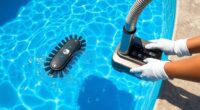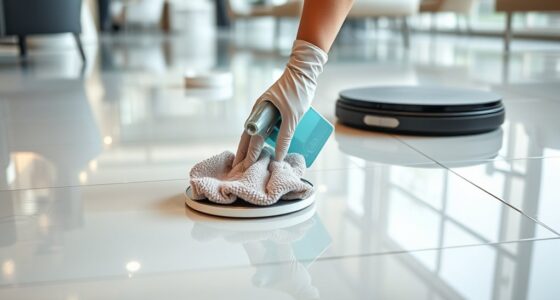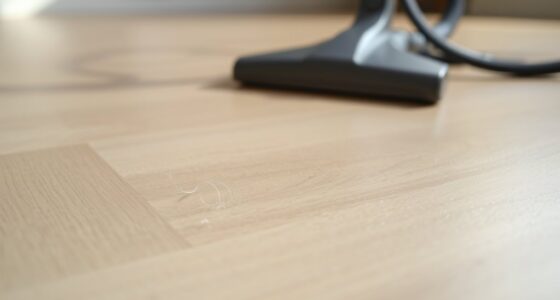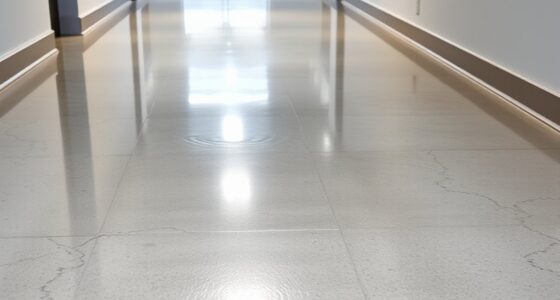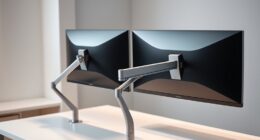To keep your salon floors looking perfect, focus on smart passes along edges and baseboards. Use small brushes or narrow attachments on vacuums to target tight spots, and damp microfiber cloths for ongoing maintenance. Regularly check for chips or damage and fix them promptly to prevent dirt buildup. Employing the right tools and techniques makes cleaning easier and more effective. Stay tuned to discover more tips that will help you master spotless floors.
Key Takeaways
- Use narrow attachments or detail brushes to effectively clean corners and along baseboards.
- Incorporate targeted passes with microfiber cloths or soft brushes for thorough maintenance.
- Regularly inspect and address damage like chips or peeling paint to prevent dirt buildup.
- Employ small handheld vacuums or crevice tools to remove dust, hair, and spills in tight spaces.
- Consistent, precise cleaning preserves the appearance and longevity of baseboards and flooring.
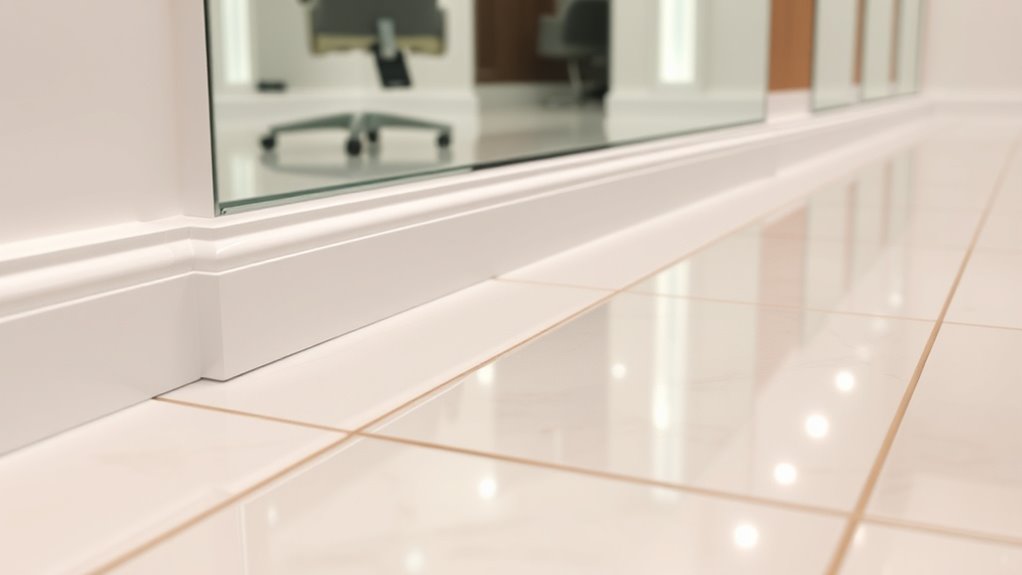
When it comes to maintaining a professional and polished salon space, paying attention to edges and baseboards on the floors is essential. These areas often get overlooked, but they play a critical role in the overall cleanliness and appearance of your salon. Dirty or damaged edges and baseboards can make even a spotless floor look unkempt. Regularly cleaning these areas not only enhances the aesthetic but also helps prevent the buildup of dust, hair, and product spills that can accumulate in tight corners and along baseboards.
Pay attention to edges and baseboards for a cleaner, more polished salon space.
The key to keeping edges and baseboards looking their best is using smart cleaning passes. Instead of just sweeping or mopping the main floor area, you need targeted techniques that reach into corners and along the base of the walls. This involves using tools like small brushes, detailers, or narrow attachments on your vacuum or cleaning machine. These tools allow you to get close to the wall without disturbing the entire floor, ensuring no debris is left behind. When you focus on making precise passes along these edges, you break up dust and hair that would otherwise settle in these tricky spots.
Another effective strategy is to incorporate regular maintenance into your cleaning routine. For instance, you can use a damp microfiber cloth or a soft-bristled brush to wipe down baseboards weekly. This helps remove any stuck-on grime or scuffs that accumulate over time. When you do this consistently, it becomes a quick, straightforward task instead of an intimidating chore. For floors with intricate baseboard molding or textured surfaces, a small handheld vacuum or a detail brush attachment can easily reach into crevices where dust hides. These smart passes prevent buildup and keep your salon looking fresh.
In addition to routine cleaning, pay attention to the condition of your baseboards and edges. If you notice chips, cracks, or peeling paint, address them promptly. Repairing damage not only improves the visual appeal but also prevents dirt from catching in damaged areas. Regular use of specialized cleaning tools can make these tasks even easier and more effective. When you invest in high-quality cleaning tools and keep up with regular maintenance, you extend the lifespan of your flooring and trim, saving money in the long run.
Ultimately, the secret to professional-looking floors lies in smart, targeted passes along edges and baseboards. They might be small details, but they make a significant difference in your salon’s overall cleanliness. When you prioritize these areas, you create a space that feels polished, inviting, and hygienic. Your clients will notice the difference, and you’ll enjoy a cleaner, more attractive environment every day.
Frequently Asked Questions
How Often Should Salon Floor Edges Be Cleaned?
You should clean salon floor edges daily to maintain a hygienic and professional environment. Regular cleaning prevents dirt, hair, and debris from building up in those hard-to-reach spots. Use a smart pass or specialized tools to guarantee thorough cleaning without wasting time. Consistent attention keeps your salon looking polished, safe for clients, and easy to maintain, ultimately enhancing the overall cleanliness and appearance of your space.
What Tools Are Best for Maintaining Baseboards?
Think of your baseboards as the frame of a beautiful picture—keeping them clean enhances the whole scene. Use a microfiber cloth for dusting to trap dirt effectively, and a gentle brush or vacuum attachment for stubborn debris. For deeper cleaning, a damp cloth with mild soap works wonders. Regular maintenance like this keeps your salon looking fresh and professional, making every detail shine just as much as your services.
Can Automated Cleaners Reach All Edges Effectively?
Automated cleaners can reach many edges effectively with the right attachments and settings. You should choose models with slim profiles, flexible brushes, or edge-cleaning modes specifically designed for corners and baseboards. Regularly check and adjust the cleaner’s position to make certain it gets close enough to edges. Combining automated cleaning with manual touch-ups guarantees a thorough job, keeping your salon floors spotless and well-maintained.
Are There Eco-Friendly Options for Baseboard Cleaning?
Think of eco-friendly baseboard cleaning options like gentle rain cleansing a garden. You can use natural solutions like vinegar mixed with water or eco-conscious cleaners that break down dirt without harsh chemicals. These options are safe for the environment and effective for removing dust and grime. By choosing biodegradable and non-toxic products, you protect your salon’s air quality and the planet, making your cleaning routine both effective and sustainable.
How Do I Prevent Damage to Delicate Baseboard Finishes?
To prevent damage to delicate baseboard finishes, you should use gentle cleaning tools like soft cloths or microfiber mops. Avoid harsh chemicals and abrasive scrubbers that can scratch or strip paint. When cleaning, work carefully along the edges and avoid excessive moisture, which can cause warping or peeling. Regularly inspect your baseboards and touch up any chipped paint to maintain their appearance and prevent further damage.
Conclusion
By paying gentle attention to the edges and baseboards, you create a seamless, polished look that subtly elevates your salon’s ambiance. Think of it as giving your space a delicate touch of refinement—like a soft whisper of elegance that leaves a lasting impression. When you master these smart passes, your floors will radiate cleanliness without a fuss, inviting clients to relax and enjoy the serene, spotless environment you’ve thoughtfully crafted.

